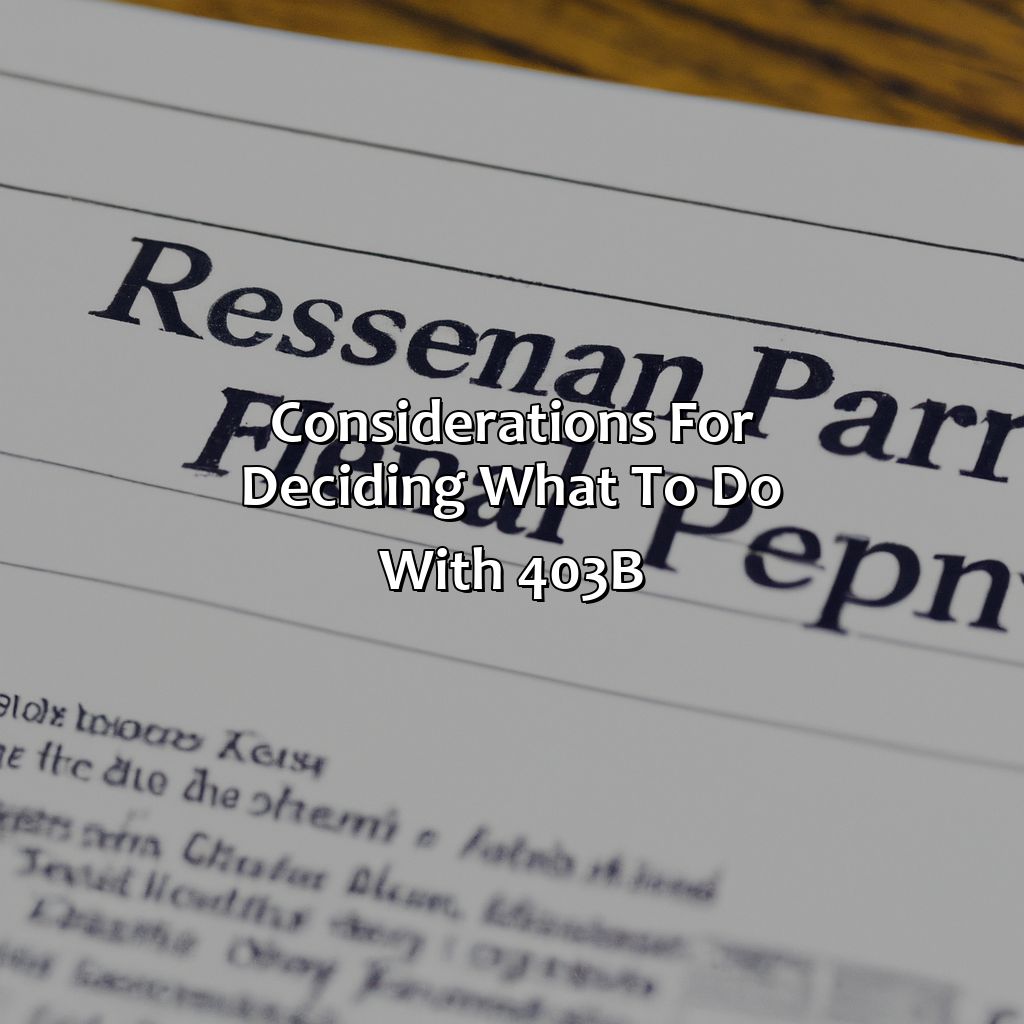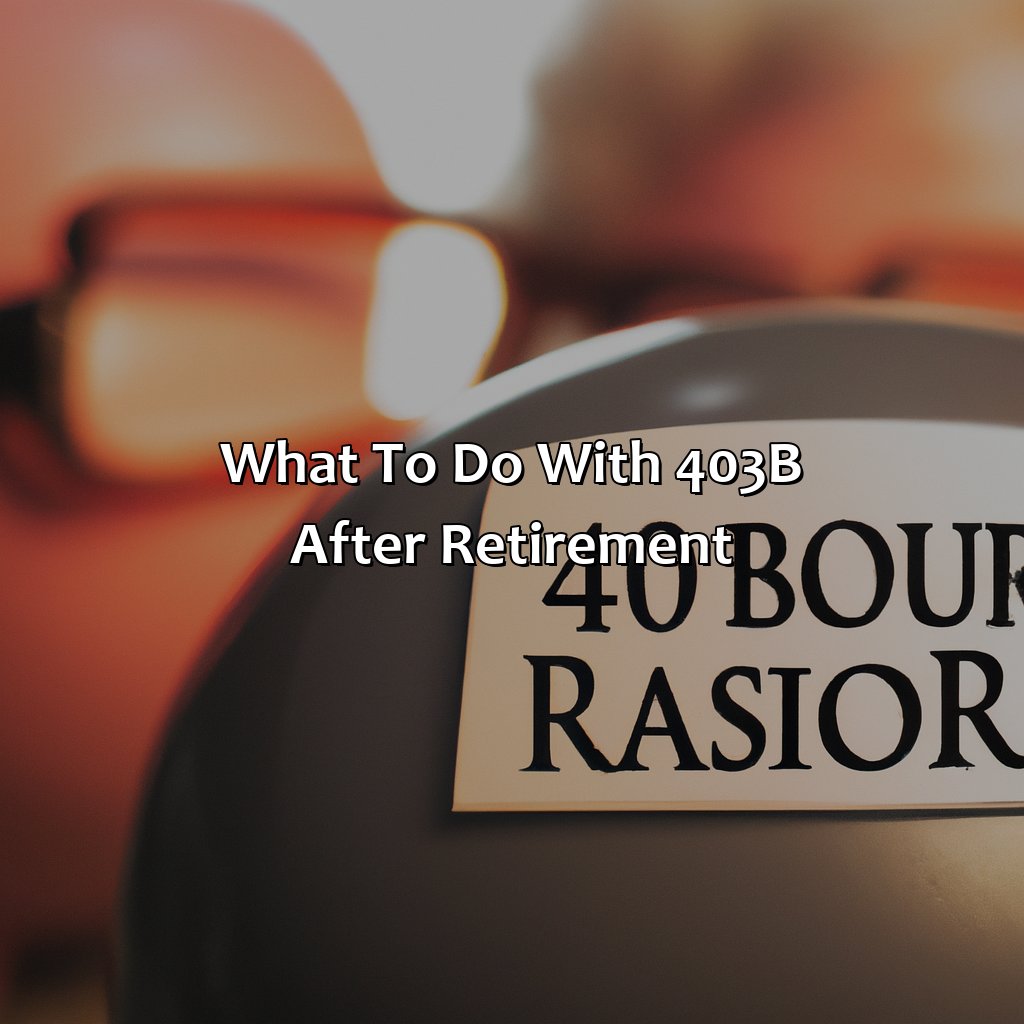What To Do With 403B After Retirement?
Key Takeaway:
- Withdraw Money from 403b: Retirees can withdraw money from their 403b retirement accounts, but they should be aware of the taxes and potential penalties for early withdrawal.
- Roll Over 403b to IRA: Another option is to roll over the 403b account into an individual retirement account (IRA) to continue growing your retirement savings and potentially access better investment options.
- Considerations for Deciding what to do with 403b: When making a decision about what to do with your 403b account, it’s important to consider your investment goals, risk tolerance, estate planning needs, and to consult with a financial advisor.
Are you worried about your finances after retirement? Don’t go into retirement unprepared, ensure a comfortable future by learning what to do with 403b after retirement. You can secure your future by making the right financial decisions.
Understanding 403b Retirement Account
The Significance of 403b Retirement Plan
403b retirement plans are tax-advantaged accounts that help employees in tax-exempt organizations save for their retirement years. These plans are essential in building a stable financial future, as they permit employees to contribute tax-deferred earnings to their accounts.
Navigating Your 403b Retirement Account
As one approaches retirement, it is essential to have a solid grasp of how their 403b retirement account works. Understanding its unique features, such as the contribution limits, distribution rules, and investment options, is imperative to make informed decisions.
Maximizing Your 403b Retirement Account
It is possible to boost your 403b retirement savings by leveraging your employer’s matching contributions or making catch-up contributions when nearing retirement age. Additionally, regularly reviewing your investment portfolio and adjusting your asset allocation as necessary may help increase your returns.
Real-Life Example of a 403b Retirement Account
Many public school employees have a 403b retirement account, including former teacher Karen. She diligently saved a considerable portion of her income, took advantage of employer matching, and diversified her investments. Today, Karen is comfortably retired, thanks to her diligent contributions to her 403b retirement account.
Options for 403b after Retirement
Want to know what to do with your 403b after retirement? This article looks at three options: Withdrawing cash, rolling it over to an IRA, or staying with your employer.
Every choice has its own benefits and drawbacks. So weigh them up carefully before deciding.
Withdraw Money from 403b
Opting for Retirement Distributions from 403b
When considering withdrawing money from 403b after retirement, assess various options like leaving the balance undisturbed, withdrawing funds over time, or taking a lump sum. Each option has an impact on taxes and future income.
Here is a five-step guide to withdrawing money from 403b:
- Review the 403b Plan provisions.
- Determine whether the account is subject to Required Minimum Distributions (RMDs).
- Estimate the amount of taxes that will result from any withdrawal option choice.
- Discuss distribution options with a financial advisor or tax professional.
- Select the most appropriate withdrawal method based on your needs and goals.
It is crucial to note that if you have retired earlier than planned, there may be penalties for early withdrawals. It’s commonly known as penalties or extra taxes. Therefore, it’s important to consider any possible consequences before moving forward.
In some rare cases, it may be advantageous to take a partial rollover into another tax-advantaged plan such as an IRA. History has shown that while taxes are baked in, reducing fees and opening new investment channels motivates savers. However, discussing this strategy with taxation professionals can help someone find out their eligibility and examine overall benefits and downsides before doing so.
By thoroughly exploring different asset allocations and withdrawal approaches with financiers before dipping one’s toes into them, someone will mitigate potential challenges related to tax planning preparedness following retirement expenditures procured via post-service plans like 403bs.
Trade in your 403b for a shiny new IRA and watch your retirement options roll right along.
Roll Over 403b to IRA
Investment Transition: Converting 403b to IRA.
The conversion of a 403b into an Individual Retirement Account (IRA) is a crucial step for retirees. Rolling over a 403b into an IRA ensures that individuals remain in control of their retirement funds and can continue to grow their savings.
Here’s a quick four-step guide on how you can roll over your 403b into an IRA:
- Contact your financial institution or IRA custodian and discuss the rollover process.
- Choose the type of IRA – Traditional, Roth, or SEP-IRA – best suited for your retirement goals.
- Complete all necessary paperwork to initiate the rollover request from your current plan administrator.
- The fund transfer will take place, allowing you full control over where and how the money is invested.
It is important to note that there are no income limitations on contributions for IRAs like those for traditional 401ks and that these accounts have more variety in investment options than employer-sponsored plans.
Tapping into bespoke investment opportunities is just one of the many benefits of converting 403b to IRA. Do not miss out on opportunities available at any point post-retirement! Make sure to be in touch with a financial advisor to better understand all the benefits suited to individual risk profiles and goals.
Take charge of your future now by converting your 403b plan to back-up your golden years inexplicably.
Leave your 403b with your employer and enjoy the feeling of being ghosted by your retirement savings.
Leave 403b with Employer
If You Choose to Retire, What Happens to Your 403b Account?
Here are five steps regarding the option of leaving your 403b account with your employer after retirement:
- Consider your employment status.
- Understand your plan’s rules and fees.
- Review investment choices and performance.
- Assess your overall retirement strategy.
- Seek advice from a financial advisor.
It’s important to note that leaving the 403b with the employer may limit future investment options and potentially result in higher costs than alternative plans.
When you decide on leaving your 403b account with your employer, ensure that you have considered all of the available options, including rolling over into an IRA or taking periodic distributions.
Don’t miss out on potential benefits by not reviewing all feasible alternatives adequately! Make sure that you are informed before making any final decisions about what to do with your 403b account in retirement.
Deciding what to do with your 403b after retirement is like choosing between wine and cheese, both delicious options but only one will satisfy your financial palate.
Considerations for Deciding what to do with 403b
Want to make an informed decision about what to do with your 403b after retirement? Consider the following for guidance:
- Taxes and penalties
- Investment goals and risk tolerance
- Estate planning
- Financial advisor consultation
Think it through carefully to determine the best option for you.

Image credits: retiregenz.com by Harry Duncun
Taxes and Penalties
The Potential Costs of 403b Withdrawals
Withdrawals from a 403b may incur both taxes and penalties. The amount of tax owed on withdrawals is determined by the individual’s tax bracket at the time of withdrawal. Additionally, if an individual withdraws funds before age 59 and a half, they may face additional penalties.
It is important to note that there are exceptions to the early withdrawal penalty, such as disability or certain types of medical expenses. Before making any decisions about withdrawing from a 403b, individuals should consult with a financial advisor to fully understand their options and potential costs.
A recent study by Fidelity found that nearly one-third of retirees make withdrawals from their retirement accounts too quickly, resulting in reduced savings for the future.
Investment goals: making bank without breaking the bank.
Investment Goals and Risk Tolerance
When making decisions about your retirement and 403b, it’s essential to consider your investments’ goals and risk tolerance. Understanding what level of risk you are comfortable with can help guide your investment strategy and ensure that your portfolio aligns with your long-term objectives.
Your investment goals may include factors such as the desired rate of return, income needs, and time horizons. By identifying these targets, you can better determine which investments will help you achieve them while managing your risk exposure.
Consider how your risk tolerance affects your asset allocation strategy. Aggressive investors may choose to invest more heavily in stocks, while conservative investors may lean towards bonds or other fixed-income securities.
It’s also important to review and rebalance your portfolio regularly to maintain an appropriate level of diversification and ensure that it remains within your desired asset allocation parameters.
An investor we worked with had a moderate risk tolerance but was heavily invested in stocks that were not performing well. We helped them understand their risk profile better and adjust their portfolio to align with their long-term financial goals while keeping within their comfort zone. Finding the right balance is crucial in achieving long-term financial success.
When it comes to estate planning, remember: your loved ones may be fighting over your assets, but at least they’ll have something to fight about.
Estate Planning
Planning for your beneficiaries after you pass away is crucial. To ensure that your estate and assets are distributed according to your wishes, it is important to formulate an estate plan. This process involves a comprehensive review of all your assets, including your 403b.
It is essential to identify the beneficiaries of this account and determine how it should be distributed. Consider creating a trust for these assets to guarantee that they are properly allocated. Be sure that you have named both primary and alternate beneficiaries and updated them regularly as life events occur.
It is also vital to hire qualified professionals who understand the nuances of estate planning laws and can guide you in making smart decisions about estate taxes, liquidity issues, privacy concerns, and beneficiary designations.
One vital aspect often overlooked in the estate planning process is reviewing your beneficiary designation forms on any retirement accounts annually or anytime there is a change in personal circumstances such as marriage, divorce or children. According to Investopedia (2021), nearly three-quarters of Americans don’t know if their 401(k) plans have high fees.
Need advice on your finances? Just remember, a financial advisor is like a GPS for your money – except they can’t reroute you from a bad investment.
Financial Advisor Consultation
Effective Financial Planning for Your Post-Retirement 403(b) Funds
Professional guidance is essential to optimize your post-retirement income and minimize financial risks. A consultation with a financial advisor can offer valuable insights for making informed decisions about managing your 403(b) account after retirement.
Your financial advisor will help you evaluate various options, such as rolling over funds into a traditional or Roth IRA or leaving your savings in the 403(b) plan. Understanding the tax implications, withdrawal rules, and investment opportunities associated with each option is critical in making an informed choice.
It’s important to keep in mind that every individual has unique financial needs, goals, and circumstances. Therefore, your consultation should be personalized to meet your specific situation and preferences.
Your advisor may recommend developing a diversified investment strategy that balances risk and reward while keeping an eye on fees. Alternatively, they might suggest annuitization or other guaranteed products that provide steady income streams well into retirement.
Ultimately, your decision should align with your long-term financial objectives and lifestyle goals. Regular reviews of your investments are critical to ensure consistency with these objectives through all phases of post-retirement life. With careful planning and expert advice from a financial professional, you can make the most of your 403(b) savings after retirement.
Five Facts About What To Do With 403b After Retirement:
You can take a lump sum distribution from your 403b account after retirement, but it may result in a large tax bill. (Source: The Balance)
You can roll over your 403b account into an IRA to avoid taxes and continue to grow your retirement savings. (Source: Fidelity)
You can also choose to keep your 403b account with your employer’s plan administrator, but this may limit your investment options and flexibility. (Source: Investopedia)
If you have a fixed annuity in your 403b account, you can choose to receive periodic payments or a lump sum payout after retirement. (Source: TIAA)
It’s important to review and adjust your retirement plan as your circumstances and priorities change in retirement. (Source: Vanguard)
FAQs about What To Do With 403B After Retirement?
What is a 403b retirement plan?
A 403b is a retirement plan for employees of non-profit organizations, such as schools, hospitals, and charities. It is similar to a 401k plan but with different rules and regulations.
What are my options for my 403b after retirement?
After retirement, you have several options for your 403b plan, including leaving the money in the plan, taking a lump sum distribution, rolling the funds over to an IRA, or purchasing an annuity.
What are the pros and cons of leaving my 403b funds in the plan after retirement?
The main advantage of leaving your funds in the plan is that the money continues to grow tax-deferred, and you do not have to pay taxes until you withdraw the funds. However, there may be fees associated with leaving your money in the plan, and you may not have as much investment flexibility as you would with an IRA.
What is a lump sum distribution, and what are the tax implications?
A lump sum distribution is when you withdraw all of the funds from your 403b plan at once. This can result in a large tax bill since the entire amount is taxable at your current tax rate. Additionally, if you are under age 59 and a half, you may also face a 10% early withdrawal penalty.
What are the advantages of rolling over my 403b funds to an IRA?
Rolling your funds over to an IRA gives you more investment options and control over your retirement funds. You can also avoid the fees associated with leaving your money in the plan. Additionally, if you opt for a Roth IRA, your funds will grow tax-free, and you will not owe taxes on withdrawals in retirement.
What is an annuity, and is it a good option for my 403b funds after retirement?
An annuity is a financial product that provides a guaranteed stream of income for a set period, typically for your lifetime. An annuity can be a good option if you want to ensure a steady income in retirement, but it may not be the best choice if you want more control over your finances or have other sources of retirement income.
 Checkout this IRS Loophole
Checkout this IRS Loophole 




